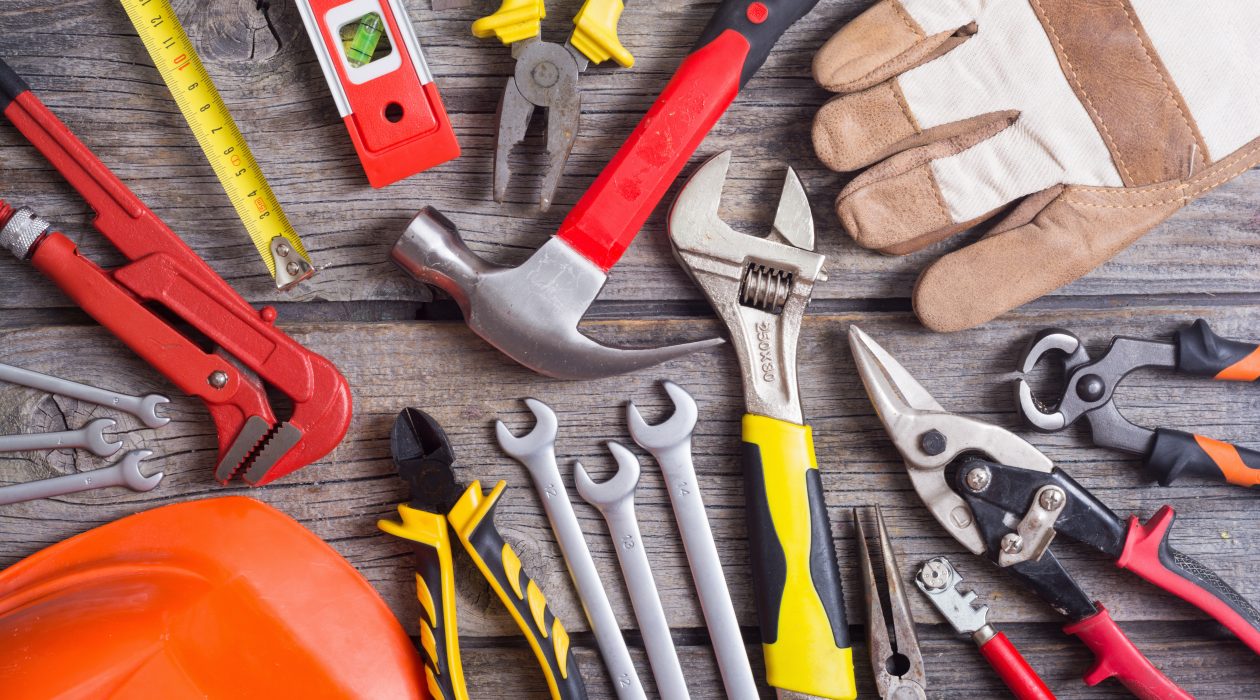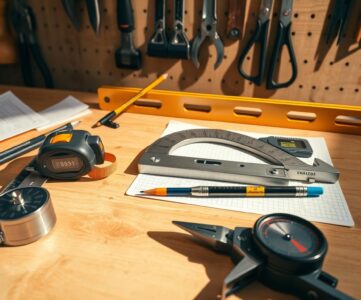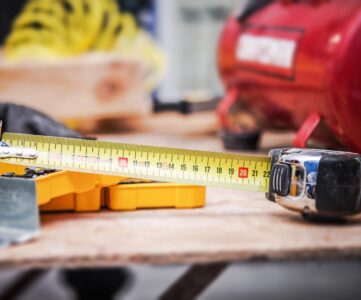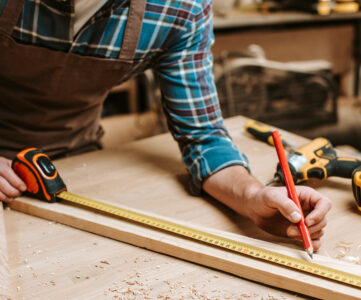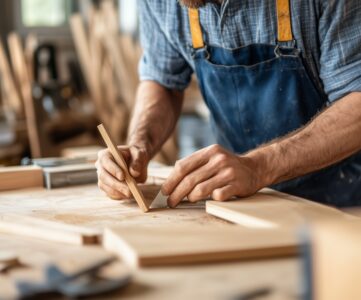DIY projects often rely on hand tools for completion. Yet, it’s easy to make mistakes that can compromise both quality and safety. Understanding proper tool handling and maintenance is essential to sidestep these errors.
Being mindful of common errors can significantly improve your DIY skills. This article will highlight frequent mistakes and provide strategies to avoid them. By doing so, you’ll enhance your project outcomes and confidence.
Introduction to Hand Tool Mistakes
Recognizing the importance of avoiding common hand tool mistakes is vital for successful DIY endeavors. By acknowledging the potential for errors, you can take proactive steps to prevent them. This ensures the highest quality and safety in your projects.
Key Takeaways
- Avoiding common hand tool mistakes is crucial for successful DIY projects
- Proper tool handling and maintenance can help prevent hand tool mistakes and DIY tool errors
- Being aware of frequent errors can help you sidestep them and achieve better outcomes
- Improving your skills and knowledge can help you become a more confident DIY enthusiast
- Recognizing the potential for hand tool mistakes and DIY tool errors is key to preventing them
Understanding the Impact of Tool Mistakes on DIY Projects
DIY projects require careful consideration of tool mistakes’ consequences. Poor tool usage can result in subpar results, increased costs, and safety hazards. Understanding these impacts helps individuals avoid common pitfalls and achieve successful outcomes. Effective hand tool tips significantly improve work quality and safety.
DIY projects involve a significant financial investment. Improper tool handling can damage materials, break tools, and cause injuries, leading to unexpected expenses. The time spent on repairs or replacements can also be substantial, extending the project timeline. By adhering to proper hand tool tips, individuals can reduce accident risks and avoid costly repairs.
How Poor Tool Usage Affects Work Quality
- Damage to materials and tools
- Increased risk of accidents and injuries
- Subpar results and decreased project quality
The Hidden Costs of Improper Tool Handling
Tool mistakes also incur hidden costs. These include replacement materials, tool maintenance, and medical expenses in case of injury. Prioritizing proper tool usage and hand tool tips helps avoid these unnecessary expenses, ensuring a successful project.
Safety Risks from Incorrect Tool Use
Safety is paramount in DIY projects. Incorrect tool use can cause serious injuries, including cuts, bruises, and fatalities. By understanding safety risks and following proper hand tool tips, individuals can minimize accidents and ensure a safe environment.
Selecting the Wrong Tool for the Job
In DIY projects, picking the right tool is key to success. Tool usage errors can cause poor results, damage tools, and pose safety risks. It’s crucial to pick the correct tool for each task to avoid these issues.
Understanding the materials a tool is meant for is a fundamental aspect. For instance, using a screwdriver to drive a nail can lead to tool usage errors and damage the material. It’s essential to choose a tool that’s designed for the specific task to ensure efficiency and safety.
Here are some tips for selecting the right tool:
- Read the tool’s specifications and instructions
- Know the material the tool is designed for
- Choose a tool that fits the task’s size and complexity
By following these tips and carefully choosing the right tool, DIY enthusiasts can prevent tool usage errors and achieve a successful project. Remember, selecting the correct tool is vital for professional-looking results and maintaining safety in the workplace.
| Tool | Material | Task |
|---|---|---|
| Screwdriver | Metal, wood | Driving screws |
| Hammer | Metal, wood | Driving nails |
| Pliers | Metal | Gripping and bending |
Poor Tool Maintenance and Storage Practices
Proper maintenance and storage of hand tools are crucial to prevent hand tool mistakes and ensure their longevity. Many DIY enthusiasts and professionals alike often overlook the importance of regular tool care. This leads to reduced performance and increased risk of accidents. To avoid such mistakes, it’s essential to establish a routine for cleaning, storing, and maintaining hand tools.
A well-maintained tool is less likely to cause hand tool mistakes and will perform better over time. Here are some tips to help you get started:
- Clean tools regularly to prevent rust and corrosion
- Apply a rust-inhibiting coating to metal tools
- Store tools in a dry, secure location, away from direct sunlight
Cleaning and Rust Prevention Tips
Cleaning your tools after each use can help prevent rust and corrosion. Use a soft cloth and mild soap to wipe down metal tools, and dry them thoroughly before storing. For tools with moving parts, apply a few drops of oil to keep them lubricated and running smoothly.
Proper Storage Solutions
Storing your tools in a designated area can help prevent loss and damage. Consider investing in a tool chest or cabinet with separate compartments for each tool. This will keep your tools organized and easy to find when you need them.
| Tool Type | Storage Solution |
|---|---|
| Hammer | Hook or peg on wall |
| Pliers | Tool chest or cabinet |
| Screwdriver | Magnetic strip on wall |
Maintenance Schedule Guidelines
Regular maintenance is key to preventing hand tool mistakes and ensuring your tools continue to perform well. Set a schedule to inspect and maintain your tools, and make any necessary repairs or replacements. By following these tips and establishing a routine for tool care, you can help prevent hand tool mistakes and keep your tools in good working condition.
Ignoring Safety Gear Requirements
When tackling DIY projects, safety must be the top priority. Many DIY enthusiasts overlook the importance of safety gear, leading to DIY tool errors and serious injuries. Safety equipment, such as gloves, safety glasses, and masks, is crucial for protecting against potential hazards.
To prevent DIY tool errors, choosing the right safety gear for each project is essential. For tasks involving power tools, safety glasses and ear protection are mandatory. When sanding or drilling, a mask is vital to prevent dust and debris inhalation. Selecting the correct safety gear significantly reduces accident risks, ensuring a safe workspace.
- Not wearing gloves when handling sharp objects or power tools
- Not using safety glasses when working with chemicals or power tools
- Not wearing a mask when sanding or drilling
Being mindful of these hazards and taking preventive measures can greatly reduce the risk of DIY tool errors. This approach ensures a successful project outcome.
Remember, safety should always be the top priority in DIY projects. By taking the necessary precautions and using the right safety gear, DIY enthusiasts can protect themselves from potential hazards and achieve professional-looking results.
Incorrect Hand Positioning and Grip Techniques
Working with hand tools requires proper hand positioning and grip techniques. This aspect is often overlooked but crucial for DIY project success. By adopting the right hand tool tips, one can achieve efficiency, safety, and quality results.
A proper grip is vital. For example, a firm but not too tight grip is key when using a hammer. This prevents accidents. On the other hand, a screwdriver needs a precise grip for straight and secure screw driving.
Essential Grip Methods for Different Tools
- Hammer: firm but not overly tight grip
- Screwdriver: precise grip for straight and secure screw driving
- Pliers: grip that allows for controlled pressure and grip adjustment
Mastering these grip methods and following hand tool tips can enhance your DIY experience. It leads to professional-like results. Remember, proper hand positioning and grip techniques are key for efficient and safe tool use.
Common Hand Position Errors
Common hand position errors include holding tools too loosely or too tightly. This can cause loss of control or fatigue. Also, avoid holding tools at awkward angles to prevent strain on the hand and wrist.
Proper hand positioning and grip techniques are essential for achieving success in DIY projects. By following the right hand tool tips and practicing proper grip methods, individuals can ensure a safe and efficient working experience.
Using Damaged or Worn Out Tools
Using tools that are damaged or worn out can lead to inefficient and dangerous work environments. This mistake can compromise both safety and performance. It’s crucial to identify signs of wear and understand when a tool needs replacement or repair.
Regularly inspecting tools can prevent tool usage errors and ensure they function properly. Common signs of wear include rust, corrosion, and damaged handles. If a tool exhibits any of these signs, it might be time for replacement or repair.
Signs of Tool Wear
- Rust or corrosion on metal parts
- Cracks or damage to handles
- Worn-out or loose moving parts
When to Replace vs. Repair
Deciding whether to replace or repair a tool depends on the damage’s extent. Severe damage might make replacement more cost-effective. Minor damage, on the other hand, could be fixed. It’s important to consider both costs and safety when deciding.
Being aware of tool wear signs and taking proactive steps to maintain and repair tools can reduce tool usage errors. This ensures a safe and efficient work environment.
The Psychology Behind Common Tool Mistakes
Hand tool mistakes often stem from psychological factors. Complacency, lack of knowledge, and haste are common culprits. Understanding these factors can help individuals avoid mistakes and enhance DIY project outcomes. For example, rushing or feeling overly confident can increase the likelihood of errors.
Psychological factors like complacency and lack of knowledge can lead to improper tool usage. Haste also plays a role, causing individuals to rush through tasks and make mistakes. Recognizing these factors helps individuals improve their tool handling skills.
To prevent hand tool mistakes, it’s crucial to be aware of these psychological factors. This includes proper tool learning, being present in the moment, and avoiding distractions. By understanding these factors, individuals can proactively prevent errors and enhance their DIY experience.
Key strategies for avoiding hand tool mistakes include:
- Taking the time to properly learn how to use a tool
- Being mindful of one’s surroundings and the task at hand
- Avoiding distractions while working
- Regularly inspecting tools for damage or wear
By following these strategies and being mindful of psychological factors, individuals can reduce their risk of error. This improves their overall DIY experience.
Understanding Tool Force and Pressure
Working with hand tools requires the right force and pressure to avoid DIY tool errors and ensure quality work. Finding the balance between force and pressure is key. Too much force can damage tools, while too little can lead to poor results.
Mastering tool force and pressure depends on the tool and task. For example, hammers need different force than screwdrivers. By understanding the needed force and managing pressure, one can lower DIY tool errors and enhance work quality.
Proper Force Application
- Assess the task and tool requirements
- Apply gentle to moderate force, depending on the task
- Use the correct grip and stance to maintain control
Pressure Point Management
Pressure points are crucial when using hand tools. Managing these points helps avoid excessive pressure, which can damage tools or cause injury. Tips for managing pressure points include:
- Using the correct tool for the job
- Applying even pressure to avoid hotspots
- Taking regular breaks to avoid fatigue
By following these tips and understanding tool force and pressure, one can reduce DIY tool errors and improve work quality. Remember, practice is key. Take time to develop your skills and master tool usage.
Environmental Factors Affecting Tool Performance
Many of us overlook the impact of environmental factors on hand tool tips. Yet, temperature, humidity, and storage conditions significantly influence tool performance and longevity. These elements can greatly affect how well your tools function.
Extreme temperatures can cause metal tools to expand or contract, impacting their accuracy and potentially leading to damage. High humidity can lead to rust and corrosion, while dry conditions can cause wooden handles to crack. To mitigate these effects, it’s essential to store your tools in a controlled environment, such as a dry, temperature-stable area.
Here are some hand tool tips for storing your tools in different conditions:
- Store tools in a dry area to prevent rust and corrosion
- Use a dehumidifier to maintain a stable humidity level
- Avoid storing tools in direct sunlight or extreme temperatures
By following these hand tool tips and taking the environmental factors into account, you can help extend the life of your tools. This ensures they perform at their best.
Building Better Tool Habits
Mastering hand tools requires good habits. A daily routine that includes tool care and maintenance is key. This approach helps avoid tool usage errors and boosts work quality. Spend a few minutes each day inspecting and cleaning tools. Also, regularly check for damage or wear.
Learning from mistakes is vital. Reflecting on past errors helps identify causes. This knowledge allows for adjustments in techniques, reducing tool usage errors. Continuous improvement makes one more proficient with hand tools, lowering accident risks.
Daily Tool Care Routines
- Regularly inspect tools for damage or wear
- Clean and maintain tools to prevent rust and corrosion
- Store tools properly to prevent damage or loss
Developing Proper Technique
Proper technique is essential to avoid tool usage errors. Practice with different tools and materials. Seek guidance from experienced professionals. Mastering the right techniques enhances work quality and minimizes accident risks.
Professional Tips for Advanced Tool Usage
As DIY enthusiasts progress, they look for professional advice to refine their tool skills. It’s vital to avoid common hand tool mistakes to achieve top-notch results. By mastering the right techniques and best practices, individuals can greatly enhance their DIY endeavors.
Experts stress the significance of choosing the correct tool for each task and keeping it in good condition. This involves regular cleaning, proper storage, and inspections to avoid damage. Also, mastering grip techniques and applying the right amount of force can prevent hand tool errors.
- Using specialized tools for complex projects
- Following industry best practices for tool maintenance and storage
- Continuously learning and improving technique to minimize hand tool mistakes
By adopting these expert tips, DIY enthusiasts can take their projects to new heights. They can achieve results that rival professional standards.
| Tool Type | Proper Maintenance | Common Mistakes |
|---|---|---|
| Hand saw | Regularly sharpen and clean | Using a dull saw, applying too much pressure |
| Pliers | Store in a dry place, inspect for damage | Using pliers with worn-out grips, applying excessive force |
Understanding Your Hand Tools for Better DIY Results
Learning to avoid common DIY tool errors is crucial for top-notch, safe, and efficient home projects. By mastering the right ways to use, maintain, and store hand tools, you can reach new DIY heights. This knowledge unlocks your full potential, elevating your skills.
Consistent practice and focus on detail are vital for better tool habits. Regularly check your tools, follow safety rules, and aim to enhance your handling skills. Adhering to these principles will lead you to professional-grade results swiftly.
So, what’s holding you back? Apply these hand tool tips and begin turning your home improvement dreams into reality. Enjoy your DIY journey!
